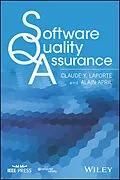This book introduces Software Quality Assurance (SQA) and provides an overview of standards used to implement SQA. It defines ways to assess the effectiveness of how one approaches software quality across key industry sectors such as telecommunications, transport, defense, and aerospace.
* Includes supplementary website with an instructor's guide and solutions
* Applies IEEE software standards as well as the Capability Maturity Model Integration for Development (CMMI)
* Illustrates the application of software quality assurance practices through the use of practical examples, quotes from experts, and tips from the authors
Autorentext
Claude Y. Laporte, PhD, has coordinated the development, implementation, and deployment of systems and software engineering processes and project management processes, and has trained software engineers in America, Europe, and Asia. Since 2000, he has been a professor at the École de technologie supérieure (ÉTS), a Canadian engineering school, where he teaches software engineering. In 2013, Professor Laporte was awarded an honorary doctorate for his contributions to software engineering. He is the Project Editor of the set of ISO/IEC 29110 systems and software engineering life cycle standards and guides developed specifically for Very Small Entities (VSEs). He has also written two French software engineering textbooks with Dr. April. Dr. Laporte is a co-author of another book targeted at managers of small systems engineering organizations.
Alain April, PhD, is a full professor of software engineering and IT at ÉTS University, Québec, Canada. He specializes in software quality assurance and IT process mapping/conformity in the industry transfer of Big Data HPC applications based on Spark, H2O.ai, and other cloud computing technologies applied to healthcare, construction, banking, and financial industries. Professor April has been developing healthcare HPC applications in the area of genomic visualization, genotyping sequencing, and whole genome sequencing, extending Berkeley's Adam data structure for HPC. These applied research projects deploy large-scale machine learning algorithms in research hospitals for specific use cases, such as type 2 diabetes early prediction and leukemia treatments in children.
Inhalt
Preface xv
Acknowledgments xxiii
1. Software Quality Fundamentals 1
1.1 Introduction 1
1.2 Defining Software Quality 2
1.3 Software Errors, Defects, and Failures 4
1.3.1 Problems with Defining Requirements 10
1.3.2 Maintaining Effective Communications Between Client and Developer 13
1.3.3 Deviations from Specifications 14
1.3.4 Architecture and Design Errors 15
1.3.5 Coding Errors 15
1.3.6 Non-Compliance with Current Processes/Procedures 16
1.3.7 Inadequate Reviews and Tests 17
1.3.8 Documentation Errors 17
1.4 Software Quality 19
1.5 Software Quality Assurance 20
1.6 Business Models and the Choice of Software Engineering Practices 22
1.6.1 Description of the Context 23
1.6.2 Anxiety and Fear 24
1.6.3 Choice of Software Practices 25
1.6.4 Business Model Descriptions 25
1.6.5 Description of Generic Situational Factors 26
1.6.6 Detailed Description of Each Business Model 27
1.7 Success Factors 32
1.8 Further Reading 33
1.9 Exercises 34
2. Quality Culture 35
2.1 Introduction 35
2.2 Cost of Quality 39
2.3 Quality Culture 49
2.4 The Five Dimensions of a Software Project 53
2.5 The Software Engineering Code of Ethics 56
2.5.1 Abridged Version: Preamble 58
2.5.2 The Example of the Code of Ethics of the Ordre des ingénieurs du Québec 60
2.5.3 Whistle Blowers 61
2.6 Success Factors 62
2.7 Further Reading 63
2.8 Exercises 63
3. Software Quality Requirements 66
3.1 Introduction 66
3.2 Software Quality Models 69
3.2.1 Initial Model Proposed by McCall 71
3.2.2 The First Standardized Model: IEEE 1061 73
3.2.3 Current Standardized Model: ISO 25000 Set of Standards 77
3.3 Definition of Software Quality Requirements 86
3.3.1 Specifying Quality Requirements: The Process 91
3.4 Requirement Traceability During the Software Life Cycle 95
3.5 Software Quality Requirements and the Software Quality Plan 95
3.6 Success Factors 96
3.7 Further Reading 97
3.8 Exercises 97
4. Software Engineering Standards and Models 101
4.1 Introduction 101
4.2 Standards, Cost of Quality, and Business Models 108
4.3 Main Standards for Quality Management 109
4.3.1 ISO 9000 Family 109
4.3.2 ISO/IEC 90003 Standard 115
4.4 ISO/IEC/IEEE 12207 Standard 117
4.4.1 Limitations of the ISO 12207 Standard 121
4.5 ISO/IEC/IEEE 15289 Standard for the Description of Information Elements 121
4.6 IEEE 730 Standard for SQA Processes 123
4.6.1 Activities and Tasks of SQA 125
4.7 Other Quality Models, Standards, References, and Processes 129
4.7.1 Process Maturity Models of the SEI 130
4.7.2 Software Maintenance Maturity Model (S 3m) 135
4.7.3 ITIL Framework and ISO/IEC 20000 138
4.7.4 CobiT Process 142
4.7.5 ISO/IEC 27000 Family of Standards for Information Security 143
4.7.6 ISO/IEC 29110 Standards and Guides for Very Small Entities 144
4.7.7 ISO/IEC 29110 Standards for VSEs Developing Systems 155
4.8 Specific Standards for an Application Domain 156
4.8.1 DO-178 and ED-12 Guidance for Airborne Systems 156
4.8.2 EN 50128 Standard for Railway Applications 159
4.8.3 ISO 13485 Standard for Medical Devices 161
4.9 Standards and the SQAP 163
4.10 Success Factors 165
4.11 Further Reading 165
4.12 Exercises 166
5. Reviews 167
5.1 Introduction 167
5.2 Personal Review and Desk-Check Review 172
5.2.1 Personal Review 172
5.2.2 Desk-Check Reviews 175
5.3 Standards and Models 179
5.3.1 ISO/IEC 20246 Software and Systems Engineering: Work Product Reviews 179
5.3.2 Capability Maturity Mode...
